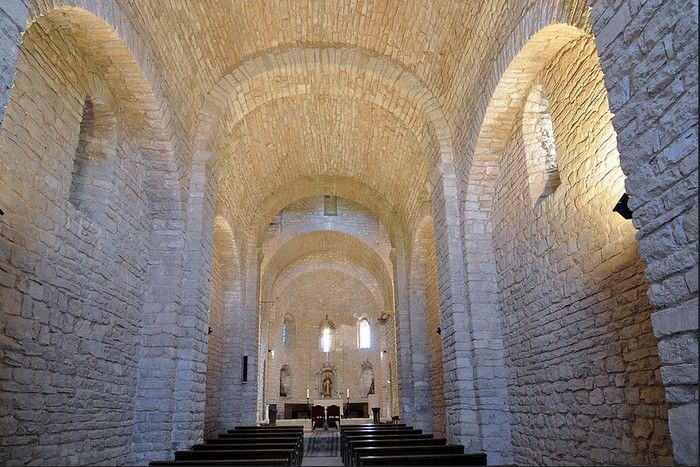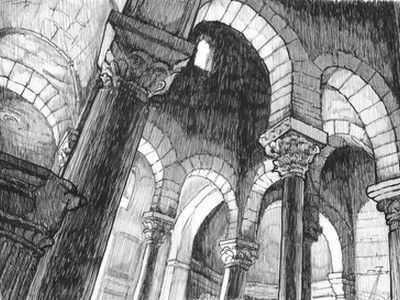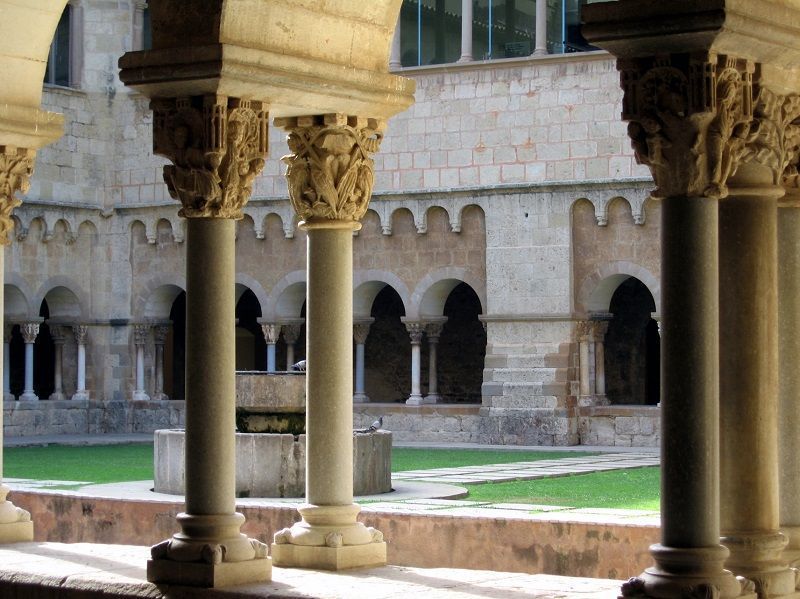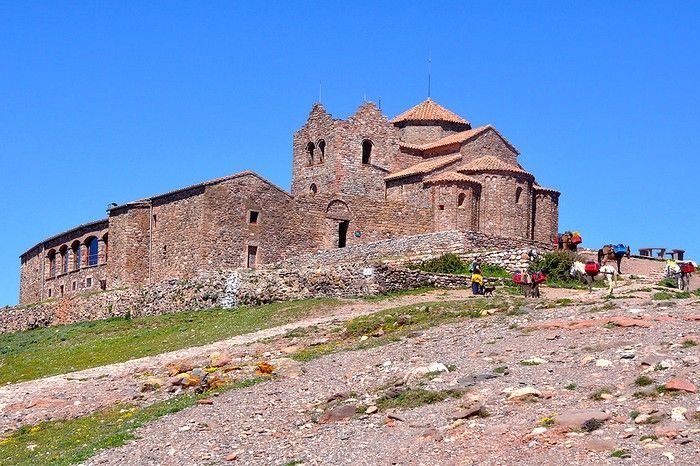SANTA MARGARIDA DEL PRIORAT DE SANT GENÍS DE ROCAFORT

Historic environment
In an environment still undeveloped today, right next to the cemetery of the town of Martorell, the remains of the church currently known by the name of Santa Margarida del Priorat de Sant Genís de Rocafort, from a factory It dates back to Late Antiquity and was in use until it was abandoned in 1936. Santa Margarida was a parish church until the 19th century, when it became a Martorell hermitage.
Since 1981, annual campaigns of archaeological excavations have been carried out that have revealed this antiquity from the discovery, below the current temple, of the foundations of a building of paleo-Christian tradition, as well as another series of archaeological indications (among them a milestone of the Emperor Maxentius) which leads us to suppose that this is the place where the mansio Ad fines was located, referenced in Roman itineraries and which has been associated with the western limit of the territorium of Barcino.
The site is part of a region, Baix Llobregat, characterized by a high density of Roman and late-antique archaeological sites that have given rise to almost all current populations.
Description
It is a building facing NE, measuring 15.25 m. long and with a main access on its south side. It is made up of a 9 m rectangular nave. wide and with a tripartite apse, formed by a horseshoe-shaped apse on the inside and trapezoidal on the outside ––with a clear parallel, geographically very close, in the recently discovered basilica of Sant Pere de Gavà––, with two adjoining side rooms ––probably sacraria–– within which it has been possible to document the presence of concavities, interpreted as cabinets for possible liturgical use. In one of these side rooms, remains of a tegulae tomb have been found, which due to its location must have corresponded to some prominent figure of the local Church. This tomb, together with another found in the center of the nave, has been brought up to point to a possible funerary origin of the church of Santa Margarida.
 The walls are built, for the most part, with irregular stones, which in some points are combined with opus spicatum. Two pavements are documented: one of mortar, which covered the entire surface of the church, and a second of opus signinum that must be related to a reorganization of the building. Associated with the first pavement, the fragmented bases of two marble stipites belonging to the first altar have been documented; while, in the same space, with the placement of the second pavement, a quadrangular stone base for a new altar is documented. A rectangular area is attached to the south wall of the church, parallel to the nave of the church, which must have been built shortly after the church was founded; Within this area is part of the necropolis that surrounds the temple, a necropolis that consists of various typologies typical of the V-VII centuries.
The walls are built, for the most part, with irregular stones, which in some points are combined with opus spicatum. Two pavements are documented: one of mortar, which covered the entire surface of the church, and a second of opus signinum that must be related to a reorganization of the building. Associated with the first pavement, the fragmented bases of two marble stipites belonging to the first altar have been documented; while, in the same space, with the placement of the second pavement, a quadrangular stone base for a new altar is documented. A rectangular area is attached to the south wall of the church, parallel to the nave of the church, which must have been built shortly after the church was founded; Within this area is part of the necropolis that surrounds the temple, a necropolis that consists of various typologies typical of the V-VII centuries.
The archaeologists responsible for the excavation date the foundation of the church between the 5th and 6th centuries, and define a second phase in which the church is monumentalized and a space is defined at the foot of the nave that, due to its location, has been interpreted as a baptistery, despite the fact that, up to now, there is no determining archaeological evidence to certify it.
It is also remarkable to highlight the presence of quadrangular structures, pillar base type, in the nave of the church and that divide it longitudinally into two equal parts. They date from an advanced post-Roman period and would be amortized towards the centuries of the High Middle Ages, when paving was done on top of these bases. They have been interpreted as provisional pillars to support the roof of the Christian building, but given their layout, their chronology and the fact that they retain traces of having contained painted decoration, this leads me to propose the possibility that it is a dividing structure. of limited temporality in order to distribute the space of worship between Christian and Muslim faiths during the brief occupation of the former territory of Ad Fines by the latter.
Jordina Sales-Carbonell for URBS REGIA
Other interesting information
Arranged visits for groups of more than 15 people.
General admission: €2.
Bibliography
-Navarro Sáez, R.; Mauri Martí, A., 1991: “La iglesia de Santa Margarida del Priorat Sant Genís de Rocafort, Martorell (Barcelona)”, en Gallo-romains, wisigoths et francs en Aquitaine, Septimanie et Espagne. Actes des VIIè Journées internationales d’archéologie mérovingienne, Rouen, 53-62.
-Navarro Sáez, R.; Mauri Martí, A., 1994: “Santa Margarida de Martorell: la transició de l’antiguitat tardana al món medieval”, en IV Congreso de arqueología medieval española, Alicante, 341-344.
-Navarro Sáez, R.; Mauri Martí, A.; Farreny Agràs, M., 1999: “Basílica de Santa Margarida de Martorell”, en Del romà al romànic: història, art i cultura de la Tarraconense Mediterrània entre els segles IV i X, ed. P. de Palol y A. Pladevall, Gran Enciclopèdia Catalana, Barcelona, 186-188.
-Travé Allepuz, E. et alii, 2019: “De l’església paleocristiana a la sagrera medieval: Transformacions estructurals i ordenament intern del jaciment de Santa Margarida (Martorell, Barcelona)”, en Tarraco Biennal. Actes 4t Congrés Internacional d’Arqueologia i Món Antic. VII Reunió d’Arqueologia Cristiana Hispànicael cristianisme en l’Antiguitat Tardana. Noves perspectives, Tarragona, 181-188.
Portals
-Navarro Sáez, R.; Mauri Martí, A., 1991: “La iglesia de Santa Margarida del Priorat Sant Genís de Rocafort, Martorell (Barcelona)”, en Gallo-romains, wisigoths et francs en Aquitaine, Septimanie et Espagne. Actes des VIIè Journées internationales d’archéologie mérovingienne, Rouen, 53-62.
-Navarro Sáez, R.; Mauri Martí, A., 1994: “Santa Margarida de Martorell: la transició de l’antiguitat tardana al món medieval”, en IV Congreso de arqueología medieval española, Alicante, 341-344.
-Navarro Sáez, R.; Mauri Martí, A.; Farreny Agràs, M., 1999: “Basílica de Santa Margarida de Martorell”, en Del romà al romànic: història, art i cultura de la Tarraconense Mediterrània entre els segles IV i X, ed. P. de Palol y A. Pladevall, Gran Enciclopèdia Catalana, Barcelona, 186-188.
-Travé Allepuz, E. et alii, 2019: “De l’església paleocristiana a la sagrera medieval: Transformacions estructurals i ordenament intern del jaciment de Santa Margarida (Martorell, Barcelona)”, en Tarraco Biennal. Actes 4t Congrés Internacional d’Arqueologia i Món Antic. VII Reunió d’Arqueologia Cristiana Hispànicael cristianisme en l’Antiguitat Tardana. Noves perspectives, Tarragona, 181-188.

















